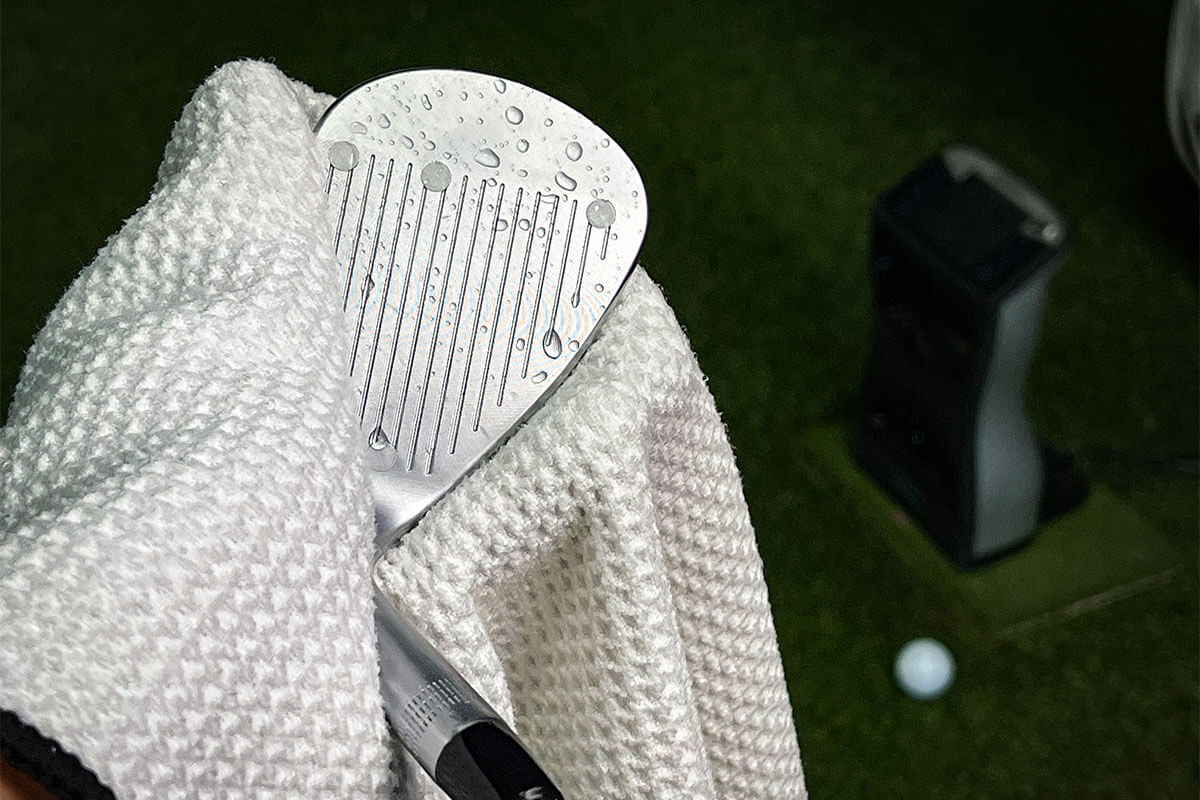One of the most pervasive myths in the golf equipment world is that rust adds spin to wedges. It’s the reason why some golfers buy raw wedges and some others go so far as to strip the finish off plated wedges.
There’s a logic to it, I suppose. Rust adds texture. Texture suggests friction and, well, friction is what provides spin.
It’s also true that a significant number of Tour pros use raw wedges. They know best, right?
It’s not much of a leap to think average golfers believe spin is the reason why raw wedges are so popular on Tour.
And so, if you happen to believe all of the above is true, it’s almost certainly easy enough to convince yourself that your wedges spin more once they get some rust on them.
Cool story, bro, but it’s just not true.
Beware of Rusty Wedges
We’ve covered the subject numerous times, most recently on No Putts Given, and every time we get pushback. Some of you love your rust, that’s for sure.
This time around, rather than ask you to take our word for it, we reached out to eight golf equipment manufacturers—Callaway, Cleveland Srixon, COBRA, Mizuno, PING, PXG and Vokey—to find out what the companies making the wedges had to say about the spin-enhancing properties of rust.
While all were invited to share any additional relevant information, we started with a simple question:
“Does rust add spin?
So, Does Rust Add Spin?
For every company—eight out of eight—the answer was the same: NO.
Rust doesn’t add spin. They’ve all tested it. They all know it’s bunk.
That’s perhaps interesting given that some of those companies in the past have, at a minimum, hinted that rust has magical spin-enhancing properties.
Bygones.
But, again, rust will not add spin to your wedges.
If that’s all you wanted to know, we’re done here. Have a great rest of your day.
Raw Versus Plated Wedges
If you’re looking for a bit more insight, then perhaps it’s time to shift the conversation.
Rusty wedges don’t spin more. That question has been settled. The more relevant question is whether un-plated wedges spin more than plated/finished wedges.
Let’s start with the basics.
Raw is simply another word for un-plated or unfinished. When we talk about raw wedges, we’re talking about clubs where manufacturers have forgone the finishing step.
No satin chrome or tour chrome. No jet black or black nickel. No slate blue (the best finish), either. When you’re buying raw, you’re buying bare, unfinished metal.
Ironically, despite requiring a bit less effort to manufacture, sometimes raw wedge can cost a bit more.
Weird (and a little scammy).
Reformatting the Rusty Wedge Question
Taking what we know to be true, let’s approach our fundamental question differently.
Do un-plated (raw) wedges spin more than plated wedges?
Again, we have an industry-wide consensus. The definitive answer is it depends.
More often than not, what it depends on is the company making the wedge.
Re-Engineering For Every Finish
I’ll try and keep this simple. Groove features—the grooves themselves along with any microgrooves, microribs, face-blasting or any other design lever manufacturers pull to enhance wedge spin—are engineered to exceedingly tight specifications.
When a finish is applied, it alters important stuff like groove depth, edge radii and the height and spacing of those “between those grooves” features I mentioned.
It’s also worth mentioning that rust has the potential to impact groove geometry in a similar (though less predictable) fashion.
Fundamentally, applying a finish changes the design of the wedge face. So if the design of your groove features hasn’t been tweaked to account for the impact of the plating, the wedge is not going to perform as designed.
All that “precision groove” stuff … fuhgeddaboudit.
Adding another variable to our equation, every finish is different, which means that each finish a manufacturer offers requires a unique reengineering of the groove features. That can be costly, which is why not every company invests the time and money to do it.
For what it’s worth, Vokey maintains that its plated wedges produce the same spin as its raw versions but others we spoke with for this piece suggested that perhaps not every company is willing to invest in redesigning groove specs to accommodate multiple finishes.
With that in mind, the “broad strokes” answer is that some finishes may perform better than others and an un-plated wedge will produce more spin than a wedge for which the design specifications haven’t been adjusted to account for the finish.
The Emergence of Raw Face Wedges
I’ll concede it’s probably not the definitive answer you were looking for but the potential for a spin boost helps explain the emergence of raw face wedges.
For its part, TaylorMade says eliminating the chrome plating from its wedges increases friction significantly. The result is upwards of a 25-percent boost in spin along with more desirable launch conditions.
Callaway, which also makes a raw-faced wedge, shared similar feedback, telling us that the raw face allows the cover of the ball to grab the edge radius of the groove as it rolls up the face.
What Callaway is describing is friction and friction is what creates spin.
The company also noted that its testing has shown that a raw face typically performs better than a plated wedge in damp conditions.
The Rule … and the Exception
What Callaway says jives with a good bit of what we’ve seen in Most Wanted wedge testing where raw wedges are always among the top performers in wet spin retention. That said, it should be noted that the best wet wedge we’ve tested to date—the PING Glide Forged Pro—is plated with PING’s proprietary Hydropearl 2.0 finish.
Again, the amount of spin generated (and retained) by plated wedges boils down to the level of effort invested in designing groove features to work with the specific characteristics of the finish material.
It’s clear that many golfers have confused the benefits of rust with the potential upside of a lack of plating. That’s understandable given a pervasive history of misdirection across the industry. Rust certainly makes for a better story than skipping the finishing step but it’s nevertheless true that rust isn’t the thing boosting spin. If anything, it’s the lack of finish.
What Does Rust Actually Do?
With all of that said, it’s reasonable to wonder what the actual impact of rust is.
The Vokey team says that, at an atomic level, rust only minimally affects surface roughness. Minimal is still something so this is where we perhaps find the exception to our rust rule.
Both COBRA and Cleveland said rust can improve spin for some shots for some period of time but not in a consistent manner.
That last detail is critical.
Unlike groove features, rust is a far cry from anything resembling precision engineering so where there is a benefit, it’s typically small, unpredictable (inconsistency is seldom a good thing in golf) and fleeting.
TaylorMade further notes that there is a point of diminishing returns where the accumulation of rust results in a loss of spin performance.
As I said, rust acts as a form of plating insomuch as that, as it accumulates, it alters the geometry of the groove features, albeit unpredictably.
That’s why it’s important to understand that the impact on spin from engineered surface textures—the between-the-groove features you’ll find on nearly every wedge—is orders of magnitude greater than rust. Those are going to have significantly more spin than rust so you’ll be much better off keeping those features clean rather than letting rust accumulate on and around them.
A bit of an aside, perhaps, but it’s worth mentioning that PING has seen golfers pick up 2,000 rpm on half and three-quarter shots simply by being fitted into the proper bounce. Score one for turf interaction, I guess.
A proper fitting is more likely to increase wedge spin than rust but, since rust is our focus today, the definitive word comes from Cleveland Golf: “The long-term trend from rusting is spin degradation.”
Iron oxide is not your friend.
Bottom line: Rust will inevitably do more harm than good to your wedges in the long run.
Other Considerations
We’d be remiss not to point out that when plating/finishing isn’t done right it can adversely affect spin as a benefit of finish is that it serves to protect the grooves. Because of the lack of plating, raw wedges will wear faster which means spin performance will degrade more rapidly than finished wedges.
If you’re on Tour and can replace your wedges frequently without cost, the accumulation of spin-reducing rust and rapid groove wear isn’t likely to be of concern. The boys in the van will make you a new one and stamp it for free—as many characters as you want.
If, however, you’re an average golfer who isn’t replacing your wedges as often as you should, the potential for a fleeting bump in spin before a more rapid decline in spin probably isn’t worth it.
If you’re not willing to replace your wedges every year or so, raw is probably the wrong answer.
A Final Word of Warning on Wedge Rust
Our final word comes from Mizuno’s Chris Voshall who says the biggest trap a golfer can fall into is rust on a wedge that isn’t designed to rust.
When that happens, it’s a sign that the grooves have been compromised and it’s time to replace the wedge.




















Jacob
2 years ago
This is just so old that in today’s market the rust can’t be compared to micro laser etched milling on modern wedges. Back in the 1970s, 80s, and early 90s it may have been a different story. I like my 1 raw wedge that I use because the glare is lower and I don’t care as much about the looks as it gets beat up with use. My 56* will continue to be a raw wedge simply for those 2 reasons.